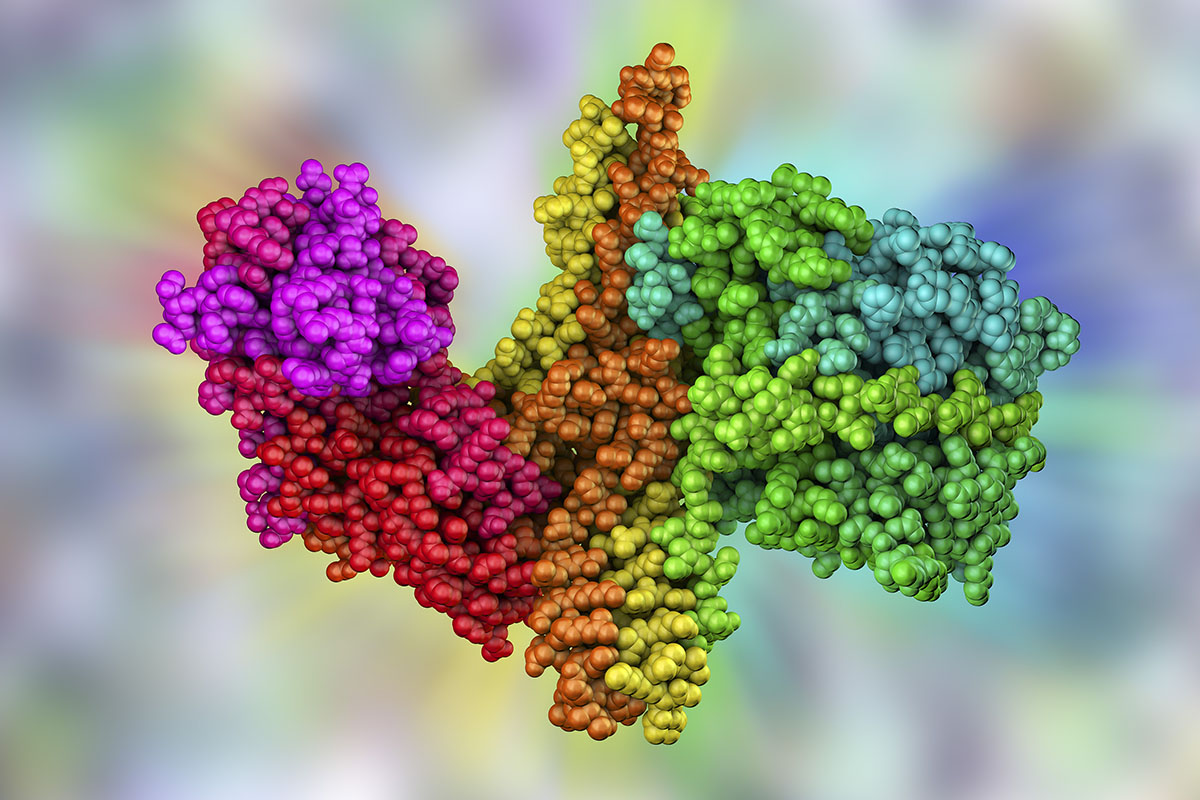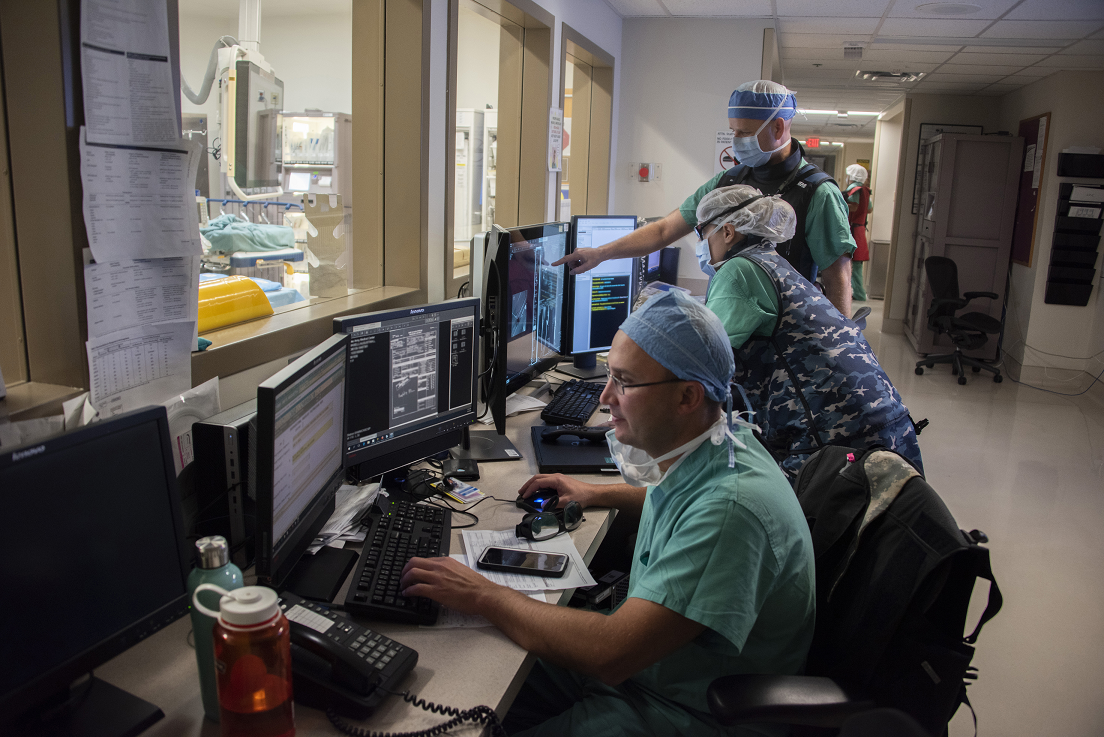Fort Detrick, MD –
“Life can change in an instant.” Many are familiar with this seemingly cliché catchphrase, intended to remind us of the unpredictability of life and of the world around us. As cliché as it may sound, threats, both natural and engineered, loom around us every single day, and without essential medical countermeasures (i.e., biologics, drugs, and devices) in place and available when the need arises, our lives are put in jeopardy. Life-altering events can, and often do, happen without warning. Be it by widespread global pandemic, naturally occurring disease, or simply a contaminated bite of food, things we often take for granted, like the ability to talk, walk, or even scratch our noses, could be gone in an instant.
Maj. Shay Hartvickson, now a 35-year-old medical doctor and Soldier, was a young and healthy 30-year-old husband and father on leave for a friend’s wedding in Ohio. A groomsman in the wedding, Hartvickson enjoyed a weekend of fun and tradition with friends the weekend of September 22, 2018, enjoying a variety of delicious catered food, drink, and, admittedly, a fair amount of homebrewed beer and wine. Setting off in the afternoon of September 23, feeling a little fatigued but otherwise normal after his busy weekend, Hartvickson had no idea how those last 48 hours would change his life.

Figure 1 - Maj. Shay HartvicksonNausea, vomiting, aspiration, difficulty speaking, eyesight impairment, and urinary retention – these were just a few of the initial symptom’s Hartvickson began experiencing the morning of September 24, and it only got worse from there. Within mere hours, convinced he was suffering no less than a stroke, he contacted emergency services and was taken to Licking County Memorial Hospital, where he wouldn’t stay for long. As bloodwork results mysteriously came back normal and CT scans came back negative, Hartvickson’s physical state only continued to decline, and after reaching the extent of the diagnostic capability of a county hospital, he was transferred to a higher level of care at Riverside Methodist. As time ticked by and it became seemingly impossible for him to breathe, he “vividly remembers” what he thought would be his last breath…before everything faded to black.
Hartvickson awoke in the Intensive Care Unit (ICU), restrained and intubated. He was lucky to be alive, but not only were his symptoms continuing to pile up, they were getting progressively worse. Now almost completely paralyzed, aside from the ability to wiggle a few fingers and toes, he was fully “locked in,” with pH levels at 6.87 - far below the tightly controlled pH level range (between 7.35-7.45) required for human life. At levels of 6.9 or less, coma, or worse, multi-organ system failure, is often imminent.
Testing continued, to include MRIs, chest x-rays, and contrast CT scans, frustratingly to no avail. Myasthenic crisis, Guillain-Barre Syndrome, Lambert-Eaton Myasthenic Syndrome (LEMS), possibly an unknown form of cancer… countless diagnoses were considered by doctors as they fought to find the root of the problem in a race against time as Hartvickson’s body continued to shut down. It wasn’t until receiving the results of an electromyography (EMG) that botulism poisoning was finally confirmed, and botulism antitoxin immediately ordered from the Centers for Disease Control and Prevention (CDC) in Chicago.
Botulism poisoning is a serious illness that is not often on the average U.S. citizen’s list of pressing health concerns. Botulinum toxin, derived from the spore-forming bacteria clostridium botulinum, is the most toxic poison known, and when introduced into the body, the poison attacks the nervous system, often leading to paralysis, respiratory failure, and ultimately death. But even with the culprit finally determined, Hartvickson’ s journey was far from over.
 Figure 2 - Molecular model of botulinum neurotoxin, courtesy of Getty Images.
Figure 2 - Molecular model of botulinum neurotoxin, courtesy of Getty Images. As he lay in his hospital bed – a feeding tube down his throat, a machine helping him to breathe, unable to move or even blink – he realized he was going to have to learn to do everything all over again.
“The first thing to come back was the ability to open my eyes,” said Hartvickson as he detailed his experience. “Next, very slowly, my upper and lower body strength returned over the course of the second week, and the biggest thing I noticed was that I was able to scratch my own nose again. But there is a lot more, and suffice it to say, I had to learn to breathe, swallow, and walk on my own all over again.”
From Riverside Methodist, Hartvickson was flown to the Brooke Army Medical Center (BAMC) ICU in San Antonio, Texas. After being released from the ICU at BAMC, he was then transferred briefly to Carl Darnell Army Medical Center at Fort Cavazos (formerly Fort Hood), before ending up at Encompass Health Rehabilitation Hospital in Austin. Finally, on October 27, 2018, he walked out of the hospital on his own two feet. Looking back now, it’s hard to tell whether it was a sip of homemade spirits or a bite of spoiled takeout that ultimately led to Hartvickson almost losing his life, but he is undoubtedly lucky to be alive.
Four years later, at the 20th biennial Shoresh Military Medicine Conference in Rockville, Maryland, it was by chance that the paths of the Joint Project Manager for Chemical, Biological, Radiological, and Nuclear Medical’s (JPM CBRN Medical) Joint Product Manager for Biological Defense Pharmaceuticals Lt. Col. Edwin Kolen crossed paths with Maj. Joseph Marcus, who spoke of his colleague Hartvickson, a botulism toxin survivor. It was this conversation which resulted in a “once in a lifetime” opportunity for the JPM CBRN Medical team to meet virtually with Hartvickson, to hear his story. Lesser-known threats like botulism are viable threats that the JPM CBRN Medical team monitors for the safety of the warfighter and the Nation, and stories like these reinforce the importance of the work that this team does.
“This is a prime example of why our office and programs exist,” said Lt. Col. Kolen. “A warfighter can’t wear a Mission Oriented Protective Posture (MOPP) suit 24-hours-a-day for every threat and under all conditions. Our office provides vaccines and treatments that provide an internal layer of defense for the warfighter that can, and will, be used in any environment.”
Serving as the Defense Department’s (DOD) premier program management office for the development and acquisition of safe, effective, and innovative medical solutions to combat CBRN threats to service members, the JPM CBRN Medical - a component of the Joint Program Executive Office for Chemical, Biological, Radiological and Nuclear Defense (JPEO-CBRND) - leads medical countermeasure (MCM) development for vaccines, diagnostics, and therapeutics. As botulinum toxin has always been on the list of top bioweapon candidate agents – given the extremely high toxicity of the agent, combined with its potential for bioterrorist attack on the nation’s food and water supplies – it is a biological threat that has been on the JPM CBRN Medical’s radar for quite some time.
 Figure 3 - Brooke Army Medical Center, Fort Sam Houston, Texas, Oct. 4, 2019. Interventional Radiology uses specially designed tools guided by several imaging techniques such as an ultrasound, computed tomography or fluoroscopy to produce real-time images. U.S. Army photo by Jason W. Edwards
Figure 3 - Brooke Army Medical Center, Fort Sam Houston, Texas, Oct. 4, 2019. Interventional Radiology uses specially designed tools guided by several imaging techniques such as an ultrasound, computed tomography or fluoroscopy to produce real-time images. U.S. Army photo by Jason W. EdwardsOver the years, the JPM CBRN Medical has played a critical role in botulinum toxin research and countermeasure development. The organization supported the sponsorship of National Stock Number (NSN) assignments for three separate MCM botulism treatments, to include Heptavalent Botulinum Antitoxin (HBAT), indicated for treatment of naturally occurring non-infant botulism; as well as FIRDAPSE® and Ruzurgi®, both approved for the treatment of LEMS, but with the potential of being repurposed for use against botulism. The team also played a significant role in the BabyBIG® effort, which utilized the JPM CBRN Medical’s recombinant Botulinum A/B (rBV A/B) vaccine. BabyBIG® is a U.S. Food and Drug Administration (FDA)-approved orphan drug (a drug developed to treat rare medical conditions) indicated for the treatment of infant botulism types A and B (BOT A and BOT B), a disease with high mortality. More recently, the JPM CBRN Medical team is maturing a product with efficacy against BOT A and BOT B toxins under its Botulinum Monoclonal Antibody (BOT MAB) program, for submission of a pre-Emergency Use Authorization (pre-EUA) package to the FDA.
“These efforts are an integral part of this organization’s overall mission to provide an integrated and layered chemical, biological, radiological, and nuclear defense capability to the Joint Force,” said Col. Matthew Clark, Joint Project Manager for the JPM CBRN Medical. “Ensuring the availability of safe and effective medical countermeasures is an essential part of emergency response involving infectious disease threats like, in this case, botulism. Delivering products like these not only supports our deployed forces, but as demonstrated here, the civilian population as well. The importance of their continued development cannot be understated.”
Maj. Hartvickson’s story is a reminder of just how important investment in preemptive research and development against lesser-known threats can be. Without these MCMs – without the existence and availability of a botulinum neurotoxin, for instance, to be administered in those critical moments when Hartvickson’s body was all but collapsing – he may not have survived to share his incredible story.
“The virtual meeting with Maj. Hartvickson was truly a ‘once in a lifetime’ opportunity,” said JPM CBRN Medical Chief Technical Officer Dr. Angela Nunley. “Maj. Hartvickson was a great presenter and answered all our questions, including staying over the allotted time for more questions. I appreciate the foresight by Lt. Col. Kolen to bring this true ‘subject matter expert’ to us, helping us advance our mission to protect the warfighter from CBRN threats.”